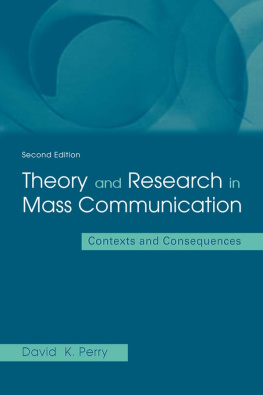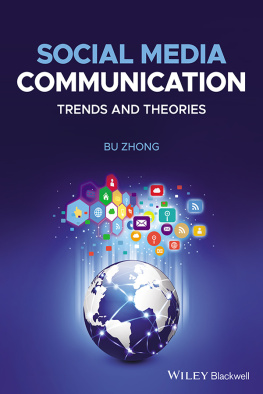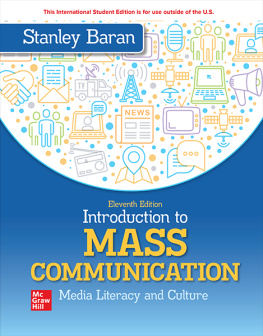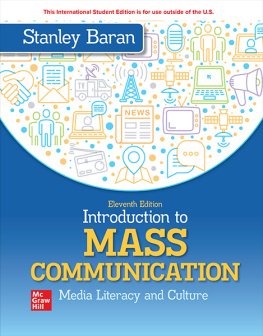Theory and Research
in Mass Communication
Contexts and Consequences
Second Edition
Theory and Research
in Mass Communication
Contexts and Consequences
Second Edition
David K. Perry
University of Alabama

First Published by
Lawrence Erlbaum Associates, Inc., Publishers
10 Industrial Avenue
Mahwah, New Jersey 07430
Transferred to Digital Printing 2009 by Routledge
270 Madison Ave, New York NY 10016
2 Park Square, Milton Park, Abingdon, Oxon, OX14 4RN
Copyright 2002 by Lawrence Erlbaum Associates, Inc.
All rights reserved. No part of this book may be reproduced in any form, by photostat, microform, retrieval system, or any other means, without the prior written permission of the publisher.
Cover design by Kathryn Houghtaling-Lacey
Library of Congress Cataloging-in-Publication Data
Perry, David K.
Theory and research in mass communication: contexts and consequences / David K. Perry.2nd ed.
p. cm. (LEAs communication series)
Includes bibliographical references and index.
ISBN 0-8058-3937-2 (cloth) ISBN 0-8058-3938-0 (pbk.)
1. Mass media Philosophy. 2. Mass media Research. I. Title. II. Series
P90.P378 2001
| 302.2301 dc21 | 01-033193
CIP |
Publishers Note
The publisher has gone to great lengths to ensure the quality of this reprint but points out that some imperfections in the original may be apparent.
Contents
APPENDIX
The Philosophical Context
This book constitutes an attempt to promote socialized intelligence, to borrow a phrase from Robert Westbrook (1991, p. 436). Traditionally, books dealing with mass communication theory and research have been largely designed for students who intend to take jobs with the media industries. My aim is wider: I want to help make this body of knowledge accessible to much larger groups of people, beginning with college students in general. Our research often has implications for the lives of everyone.
In attempting to reach a wider audience, I have continued in the second edition to rely on ideas from the philosophical tradition known as American pragmatism. Pragmatism may best be characterized as the attempt to assess the significance for human values of technology in the broadest sense (Kaplan, 1961, p. 14). In this sense, technology includes not only the mass media, but scientific research. In comparison to the first edition, however, I have placed more emphasis on ideas from the Social Pragmatists (see Campbell, 1995). For example, readers can find a discussion of the social, symbolic nature of mind in , this book is designed as a civic journalism presentation of research in our field.
My argument is that researchers, like journalists, need to connect with the broader communities in which they live. However, this should not be taken as advocacy of abandonment of what Kaplan (1964) called the autonomy of inquiry. Of course, the various sciences, taken together, must work independently of external controls. In fact, history shows that scientific progress depends on a lack of subservience to ideological, philosophical, political, and religious ends. Rather, the argument is that scientists should not avoid a concern with the potential real-world implications of their work that people in the broader community may value. Researchers need to connect in part as a means of increasing public support for their work, perhaps avoiding a future financial depression similar to what the universities experienced during the early 1990s.
A number of other changes from the first edition appear. includes a rather extensive update of the TV violence controversy. Readers may also find additions of recent research throughout the volume.
As with the first edition, a guiding principle of the book is that the broader society in which we live conditions and (at least potentially) is conditioned by research. In other words, the social and historical contexts of our lives contribute to (without necessarily determining) social science theory and research, which in turn can have important consequences for society. Hence the title phrase, contexts and consequences. In discussing the possible consequences of research, I assume the Deweyan argument that whenever technological institutions fail to enhance desirable human goals there needs to be more, not less, technology (Hickman, 1995, p. 86). In short, assessing the impact of research on society potentially can help prevent undesirable consequences.
A number of the chapters follow the logic of the pragmatist maxim, which Charles Peirce first formulated in 1878 and on which many others have elaborated. According to one version, the meaning of an idea comes from the difference it would make for us if it were true. For example, what are the empirical consequences of the idea that TV contributes to crime? How might this help us in future research or in understanding the world in which we live? At least as important, how might we use such knowledge to improve our lives?
In this light, theory and research are not seen as a means by which the human mind mirrors an external world. Rather, in Rortys (1982) words, they can be seen as vocabularies as instruments for coping with things (p. 198). Like all human products, they are fallible. An acquaintance with the work of philosophers in the pragmatist tradition makes it seem very unlikely, and probably impossible, that science could provide certain, infallible conclusions about media issues, such as the impact of televised violence. This applies, as well, with arguably more settled issues such as those concerning the impact of smoking on cancer rates or sexual behavior on AIDS transmission. A possible doubt always is possible. We have to ask ourselves instead if such doubts are reasonable. Then we have to do the best we can with what we know.
Although only one person is listed as the author of this book, many others contributed to its existence. Among those who provided useful comments regarding drafts of chapters in the first edition were several of my colleagues in the College of Communication (now the College of Communication and Information Sciences) at the University of Alabama: Jennings Bryant, William Melson, Yorgo Pasadeos, Joe Phelps, and David Roskos-Ewoldsen. John McNelly, professor emeritus at the University of Wisconsin-Madison, commented on a number of chapters. Various graduate research assistants at Alabama also helped out. These included Clay Rossi, William Self, and Shyam Sundar Sethuraman. In completing the second edition, my research assistants John Carmichael and Peiqin Zhou helped me locate pertinent literature. Finally, the author wishes to thank the Erlbaum staff and three Erlbaum reviewers for their many helpful comments concerning the first and second editions. Of course, these people bear no responsibility for whatever mistakes remain.
Citizens, policymakers, and communication practitioners who are concerned about mass communication issues often turn to the academic community for answers. Their questions often involve such things as whether, to what extent, or why media violence or sex contributes to antisocial or criminal behavior among audiences. The answers often are not as simple or consistent as they might like. As one scholar put it:
only after much research has been completed does a statement come to be viewed in the scholarly community as true a status very few communication theories are ever likely to reach. Even then, the truth value is to be found more in the degree of agreement among scholars, an intersubjective criterion, than in any ultimate reality. (Chaffee, 1991, p. 11)







